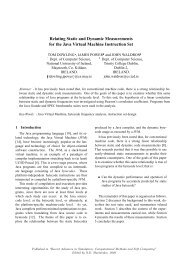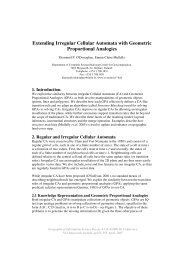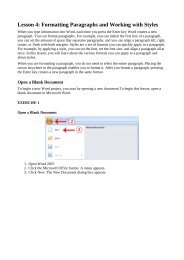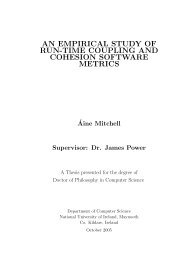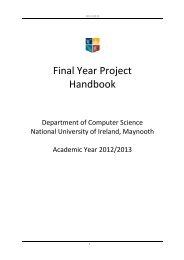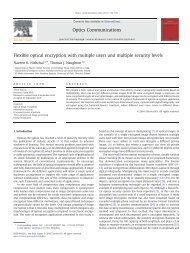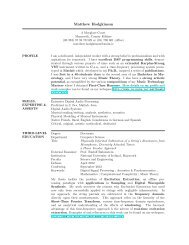Test Case Generation for Programming Language Metamodels
Test Case Generation for Programming Language Metamodels
Test Case Generation for Programming Language Metamodels
Create successful ePaper yourself
Turn your PDF publications into a flip-book with our unique Google optimized e-Paper software.
Incorporating at least a language’s static semantics into test suite generation<br />
must go beyond simple context-free grammars. One possible approach is to use<br />
attribute grammars, and to seek to exploit the attribute equations to constrain<br />
or even direct the generation of test cases [3, 4]. Despite this research, it is still<br />
not a trivial task to directly extend this work to a metamodelling environment<br />
that uses, <strong>for</strong> example, OCL-like constraints <strong>for</strong> describing the static semantics.<br />
It is possible to borrow some ideas from software modelling, and there is a<br />
great deal of existing research dealing with model-based testing strategies [5,<br />
6]. However, much of this work focuses on the behavioural elements of software<br />
models (such as state machines), rather than the structural aspects which might<br />
be more relevant to metamodelling.<br />
In the context of testing structural models, two tools strike us as being particularly<br />
noteworthy:<br />
– USE (a UML-Based Specification Environment) which allows the user to<br />
specify a UML (Unified Modeling <strong>Language</strong>) class diagram with OCL constraints<br />
[7]. From these we can manually generate corresponding object diagrams,<br />
and the USE environment will check that these are valid instances,<br />
satisfying the relevant class invariants.<br />
– Alloy which has its own logical specification language, corresponding roughly<br />
to the elements found in a class diagram, and automatically generates object<br />
diagrams that correspond to this specification [8]. One of the useful aspects<br />
of the Alloy tool is that it is designed to work with a number of different<br />
SAT solvers in order to test constraints and generate counter-examples.<br />
As part of an earlier project, we have previously exploited the close relationship<br />
between the Alloy notation and UML class diagrams to generate instances<br />
of a metamodel <strong>for</strong> software metrics [9]. One of the drawbacks of this<br />
earlier approach is that it did not control the strategy used to generate instances.<br />
Faced with the impossibility of manually validating several hundred thousand<br />
instances, we exploited test-suite reduction techniques to narrow the set of test<br />
cases.<br />
3 Proposed Solution<br />
It is clearly inefficient to generate test cases that are not used, and an ideal<br />
solution would be to generate an appropriate set of test cases in the first place. Of<br />
course, this immediately raises two questions: what do we mean by an appropriate<br />
set of test cases, and how do we generate these test cases<br />
One way of measuring the adequacy of a set of test cases <strong>for</strong> a piece of<br />
software is to use coverage criteria. Typically, a test suite can be judged in terms<br />
of the percentage of statements, decisions, branches etc. in the source code that<br />
are executed when the software is run. It seems natural there<strong>for</strong>e to attempt to<br />
seek to assemble a test suite <strong>for</strong> a metamodel along similar lines, i.e. to <strong>for</strong>m a<br />
set of models that cover the features of the metamodel. In terms of programming<br />
language metamodels, this would involve creating a set of programs that exercise<br />
the features of the language.<br />
2



